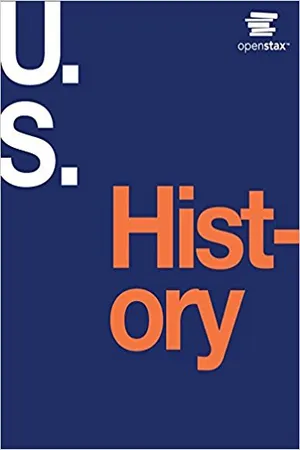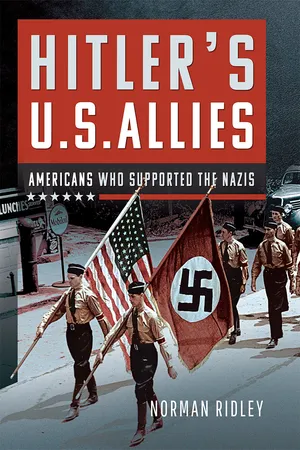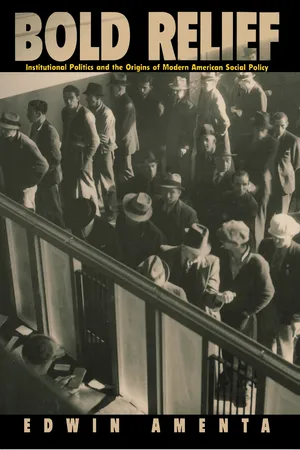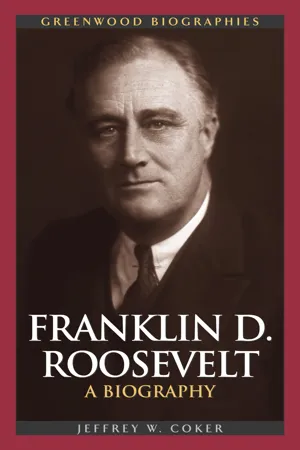History
The New Deal
The New Deal was a series of programs and reforms implemented by President Franklin D. Roosevelt in the 1930s to combat the Great Depression. It aimed to provide relief, recovery, and reform through measures such as public works projects, financial regulations, and social welfare programs. The New Deal significantly expanded the role of the federal government in the economy and had a lasting impact on American society.
Written by Perlego with AI-assistance
Related key terms
1 of 5
9 Key excerpts on "The New Deal"
- Elizabeth Cobbs, Edward Blum, Jon Gjerde, , Elizabeth Cobbs, Edward Blum, Jon Gjerde(Authors)
- 2016(Publication Date)
- Cengage Learning EMEA(Publisher)
Its cardinal aim was not to destroy capitalism but to devolatilize it, and at the same time to distribute its benefits more evenly … . … And ever after, Americans assumed that the federal government had not merely a role, but a major responsibility, in ensuring the health of the economy and the welfare of citizens. That simple but momentous shift in perception was the newest thing in all The New Deal, and the most consequential too. Humankind, of course, does not live by bread alone. Any assessment of what The New Deal did would be incomplete if it rested with an appraisal of New Deal economic policies and failed to acknowledge the remarkable array of social inno-vations nourished by Roosevelt ’ s expansive temperament … . THE DEPRESSION, The New Deal, AND FRANKLIN D. ROOSEVELT 243 Copyright 2017 Cengage Learning. All Rights Reserved. May not be copied, scanned, or duplicated, in whole or in part. Due to electronic rights, some third party content may be suppressed from the eBook and/or eChapter(s). Editorial review has deemed that any suppressed content does not materially affect the overall learning experience. Cengage Learning reserves the right to remove additional content at any time if subsequent rights restrictions require it. For all his alleged inscrutability, Franklin Roosevelt ’ s social vision was clear enough. “ We are going to make a country, ” he once said to Frances Perkins, “ in which no one is left out. ” In that unadorned sentence Roosevelt spoke volumes about The New Deal ’ s lasting historical meaning. Like his rambling, comfortable, and unpretentious old home on the bluff above the Hudson River, Roosevelt ’ s New Deal was a welcoming mansion of many rooms, a place where millions of his fellow citizens could find at last a measure of the security that the patrician Roosevelts enjoyed as their birthright.- No longer available |Learn more
- (Author)
- 2014(Publication Date)
- Research World(Publisher)
The number of unemployed in 1929 was estimated at less than 4%, but by 1933 the unemployment rate had jumped up to approximately 25%. The New Deal was designed for complete economic recovery during the depression. However, The New Deal did not achieve full economic recovery. It actually had a limited economic impact. The New Deal failed to lower the unemployment rate below 14%. However, The New Deal did help maintain an average of 17% level the unemployment throughout the 1930s. Mo st scholars believe that there were three versions of The New Deal in between 1933 and 1940. The first New Deal took place between 1933 and 1935 and was focused on both farm and factory. The second New Deal was introduced in 1935. In this New Deal, the country's welfare system was dramatically changed and expanded. One example of The New Deal’s new welfare programs was the Works Progress Administration (WPA), which was created to “return the unemployed to the work force”. During The New Deal period, the federal government evolved into an arbitrator in the competition among elements and classes of society, acting as a force to help some groups and limit the power of others. This elevated and strengthened newer interest groups which allowed these to compete more effectively. By the end of the 1930s, business found itself competing for influence with an increasingly powerful labor movement, with an organized agricultural economy, and occasionally with aroused consumers. This was accomplished by creating a series of government institutions that greatly and permanently expanded the role of the federal government. Thus, perhaps the strongest legacy of The New Deal was to make the federal government a protector of interest groups and a supervisor of competition among them. - eBook - PDF
- P. Scott Corbett, Volker Janssen, John M. Lund, Todd Pfannestiel, Paul Vickery, Sylvie Waskiewicz(Authors)
- 2014(Publication Date)
- Openstax(Publisher)
Chapter 26 | Franklin Roosevelt and The New Deal, 1932-1941 761 Visit the American Presidency Project (http://openstaxcollege.org/l/fdraug) to listen to Roosevelt’s first inaugural speech and identify ways he conveyed optimism and a spirit of community to his listeners. 26.2 The First New Deal By the end of this section, you should be able to: • Identify the key pieces of legislation included in Roosevelt’s “First New Deal” • Assess the strengths, weaknesses, and general effectiveness of the First New Deal • Explain Roosevelt’s overall vision for addressing the structural problems in the U.S. economy Much like a surgeon assessing the condition of an emergency room patient, Roosevelt began his administration with a broad, if not specific, strategy in mind: a combination of relief and recovery programs designed to first save the patient (in this case, the American people), and then to find a long- term cure (reform through federal regulation of the economy). What later became known as the “First New Deal” ushered in a wave of legislative activity seldom before seen in the history of the country. By the close of 1933, in an effort to stem the crisis, Congress had passed over fifteen significant pieces of legislation—many of the circulated bills allegedly still wet with ink from the printing presses as members voted upon them. Most bills could be grouped around issues of relief, recovery, and reform. At the outset of the First New Deal, specific goals included 1) bank reform; 2) job creation; 3) economic regulation; and 4) regional planning. REFORM: THE BANKING CRISIS When Roosevelt took office, he faced one of the worst moments in the country’s banking history. States were in disarray. New York and Illinois had ordered the closure of their banks in the hopes of avoiding further “bank runs,” which occurred when hundreds (if not thousands) of individuals ran to their banks to withdraw all of their savings. In all, over five thousand banks had been shuttered. - Available until 27 Jan |Learn more
The Achievement of American Liberalism
The New Deal and Its Legacies
- William H. Chafe, William Chafe(Authors)
- 2002(Publication Date)
- Columbia University Press(Publisher)
The New Deal launched other programs as well, offering financial assis-tance to imperiled homeowners, farmers, and small businesses. Even taken to-gether, these early relief programs were modest when measured against the gravity of the problems they were trying to address. For the people they helped, they were a godsend. For millions of others, they were simply an al-luring but unattainable promise. These early experiments in providing relief revealed both the extent and the limits of The New Deal commitment to social welfare. Roosevelt and those around him clearly rejected the rigid conservative views of those who considered any aid to the poor dangerous and improper. In 1931, as gover-nor of New York, Roosevelt had challenged that orthodoxy. Government had a clear responsibility, he told the state legislature, “when widespread eco-nomic conditions render large numbers of men and women incapable of supporting either themselves or their families because of circumstances be-yond their control which make it impossible for them to find remunerative labor. To these unfortunate citizens aid must be extended by government— not as a matter of charity but as a matter of social duty.” 4 As president, he continued to reject the conservative argument against social assistance. But Roosevelt, Hopkins, and most of the other critical figures in shaping The New Deal welfare state also feared the debilitating effects of what was still widely known as “the dole.” Harry Hopkins, looking at the effects of the FERA in 1933, said, “I don’t think anybody can go on year after year, month after month accepting relief without affecting his character in some way un-favorably. It is probably going to undermine the independence of hundreds of thousands of families . - eBook - PDF
Hitler's U.S. Allies
Americans Who Supported the Nazis
- Norman Ridley(Author)
- 2024(Publication Date)
- Frontline Books(Publisher)
So what was there in Roosevelt’s New Deal that warranted such criticism? He tackled banking reform laws to allow credit to flow into the economy again. He set out emergency relief programmes through a Social Security system that provided pensions for seniors and support for mothers with children. Work relief programmes created jobs for ten million workers and agricultural programmes saw farm prices stabilised. Hundreds of thousands of new roads, bridges, and tunnels; city halls, libraries and post offices; hospitals, schools and auditoriums; dams, water works and sewage systems; and airports, parks and military installations were built. The New Deal 65 All this had consequences for the power structure. Democratic controls were increasingly transferred from the legislature to the executive and followed the pattern of economic power as political power became more concentrated. The President of the United States was given enormous discretionary power over vast funds that were made available to him. Over the course of three years, he created a plethora of agencies to administer these funds. • AAA (Agricultural Adjustment Administration) • CCC (Civilian Conservation Corps) • CWA (Civil Works Administration) • FDIC (Federal Deposit Insurance Corporation) • FERA (Federal Emergency Relief Administration) • FSA (Farm Security Administration) • NRA (National Recovery Administration) • NYA (National Youth Administration) • PWA (Public Works Administration) • REA (Rural Electrification Administration) • RFC (Reconstruction Finance Corporation) • SEC (Securities and Exchange Commission) • SSA (Social Security Administration) • TVA (Tennessee Valley Authority) • WPA (Works Progress Administration). There ensued what some have called a government by bureaucracy, but it went further than that because the real economic power rested with the dominant economic forces active in each situation. - eBook - PDF
Party Polarization in America
The War Over Two Social Contracts
- B. Dan Wood, Soren Jordan(Authors)
- 2017(Publication Date)
- Cambridge University Press(Publisher)
106 New Deal Social Contract from Depression to World War II On March 12, President Roosevelt conducted his first Fireside Chat with the American people (Roosevelt 1933a). He used this first of thirty radio addresses to assure Americans that the banking system was now safe. The following day the president lifted the bank holiday, and authorized banks were opened for business. Citizens formed long lines to deposit their hoarded money. That same day the stock market registered its approval with its largest one-day percentage gain in American history. From this point forward, the banking system was stable. Over the next three months, the president and new Democratic Congress acted decisively to bring relief to those Americans hit hardest by the depression. As discussed earlier, a hallmark of depression economics was deflation. As noted by Schlesinger (1958, 195), “On the day of Roosevelt’s inauguration, the index of wholesale commodity prices was at 59.6 percent of its 1926 level, of farm commodities at 40.6 percent. The dead weight of debts contracted at higher price levels threatened to collapse the entire economy – unless prices could somehow be increased.” Further, as discussed in Chapter 3, price deflation produced an incentive to hoard money, and a disincentive for those with money to consume and invest. With prices in decline, the value of money was rising. As a result, holders of money could simply wait in predatory fashion for prices to drop sufficiently before resuming consumption and investment. For holders of money to return to normal patterns, an inflationary stimulus was required to make money less valuable when sitting idle. The Roosevelt administration tackled these problems through a series of actions that removed the United States from the gold standard. Continued adherence to the gold standard meant that the money in circulation was restricted by the amount of gold held by Federal Reserve banks. - eBook - PDF
Bold Relief
Institutional Politics and the Origins of Modern American Social Policy
- Edwin Amenta(Author)
- 2021(Publication Date)
- Princeton University Press(Publisher)
C H A P T E R S I X Redefining The New Deal, 1940-1950 The one thing which must be extended if we would help the young men and women of the nation, is to give them the opportunity to work. We have recognized that to the right to vote, the right to learn, the right to speak, the right to worship, we, your Government, add the right to work. -Franklin D. Roosevelt, October 23, 1940 I. There must be work for all who are able and willing to work. We all accept this principle. —National Resources Planning Board Committee on hong-Range Work and Relief Policies, December 4, 1941 I am proud of the Work Projects Administration organization. It has displayed courage and determination in the face of uninformed criticism. The knowledge and experience of this organization will be of great assistance in the consideration of a well-rounded public works program for the postwar period. With the satisfaction of a good job well done and with a high sense of integrity, The Work Projects Administration has asked for and earned an honorable discharge. — Franklin D. Roosevelt, December 4, 1942 HOPES WERE HIGH among reformers in the Roosevelt Administration that The New Deal work and relief policy, which had come so far in the 1930s, might be completed in the 1940s. 1 The president was still popular and sig-naled his intention to lead the nation during the world crisis by running for a third term. Policy experts situated in the National Resources Planning Board (NRPB), the Work Projects Administration (WPA), and the Federal Security Agency were documenting problems in the social spending system and ways to address them. New Dealers also were planning to alter the nature of American taxation, whose provisions had evolved haphazardly in the Depression. As American participation in the European war loomed, the hopes of the reformers seemed on their way to being realized. Roosevelt ran the 1940 campaign mainly as a referendum on his domestic policy and the need to - eBook - PDF
- Jane Kamensky, Carol Sheriff, David W. Blight, Howard Chudacoff(Authors)
- 2018(Publication Date)
- Cengage Learning EMEA(Publisher)
The seem- ing unity of the First Hundred Days masked deep divides within the nation, and once the immediate crisis was averted, the struggle over solutions began in earnest. As some tried to stop the expansion of government power, others pushed for increased governmental action to combat continuing poverty and inequality. Pressure came from all directions as the presi- dent considered the next phase of New Deal action. 22-3a Business Opposition As the economy partially recovered, many wealthy busi- ness leaders started publicly criticizing The New Deal. They condemned budget-busting government spending for relief and jobs programs, as well as the regulations and rising taxes that affected them directly. In 1934, several corporate leaders joined with former presi- dential candidate Al Smith and disaffected conservative Democrats to establish the American Liberty League, an economically conser- vative organization that waged a highly visible cam- paign against New Deal “radicalism.” Attempting to 22-2f Lowering Tariffs Internationally, meanwhile, the Roosevelt administration worked to expand trade. Increased trade, Secretary of State Cordell Hull insisted, would not only help the United States pull itself out of the economic doldrums but also boost the chances for global peace. Calling the protective tariff the “king of evils,” he successfully pressed Congress to pass the Reciprocal Trade Agreements Act in 1934. This important legislation empow- ered the president to reduce U.S. tariffs by as much as 50 percent through special agreements with foreign countries. The central feature of the act was the most-favored-nation principle, whereby the United States was entitled to the lowest tariff rate set by any nation with which it had an agreement. - eBook - PDF
Franklin D. Roosevelt
A Biography
- Jeffrey W. Coker(Author)
- 2005(Publication Date)
- Greenwood(Publisher)
LAUNCHING The New Deal 99 Bills originated in the legislature on a regular basis requesting more funds for employment projects in all parts of the country. During the Hundred Days, the administration announced the creation of a new Public Works Administration; Congress not only approved the plan but also requested five billion dollars, which was far more than even Roosevelt had envisioned. The new agency, under the watch of Secretary of the Interior Harold Ickes, accepted proposals for projects such as high- way construction, bridges, ports, and buildings. For the results-oriented president, public works was an attractive means for recovery. Public works projects also were more attractive than direct relief, as Roosevelt agreed with Hoover that direct unemployment payments could become, as he called them, a "narcotic" that might lull people into complacency and dependence. The main problem was the cost. Massive projects required enormous spending that would strain the national budget and lead ulti- mately to deficits—a scenario that Roosevelt was unwilling to contem- plate in the first years of his presidency. With time, however, Roosevelt began to change his attitude regarding the dangers of deficits, which sparked an explosion of new works pro- grams. For some time, economists in the United States had been moving to the view that increased government spending could be instrumental in fueling economic growth. The British economist John Maynard Keynes did more to popularize the use of deficit spending to promote growth; by the time Roosevelt became president this theory was becoming more accepted in academic circles. By the end of his first term in office, the administration had moved to accept Keynesian theory as part of its eco- nomic recovery program. The influx of dollars into the economy through government spending, the thinking went, might "prime the pump" of the economy and trigger expansion that eventually would overcome any short-term deficits.
Index pages curate the most relevant extracts from our library of academic textbooks. They’ve been created using an in-house natural language model (NLM), each adding context and meaning to key research topics.








